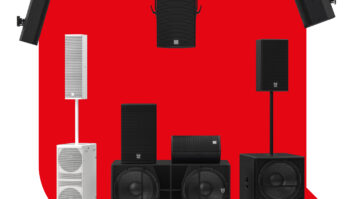SAFETY HARBOR, FLORIDA:
When The Kills went on a tidy fifteen-show tour of North America in support of Blood Pressures (Domino Records), culminating in their ten year anniversary show in New York City, they brought along trusted FOH and recording engineer Philip Harvey (Modest Mouse, White Stripes). In addition to delivering the tuneful and carefully-crafted lo-fi of The Kills to the fans who flocked to see the duo in the flesh, Harvey was also charged with the task of recording the shows. On loan from the Amsterdam Recording Company, where he serves as head engineer, Harvey crossed the ocean with his trusted Metric Halo interfaces and the confidence that they would capture the musical soul of the band’s performance night after night.
Harvey was introduced to Metric Halo gear and software during his seven-year tenure as the FOH engineer with Medeski Martin & Wood. “It was around 2000 when the folks from Metric Halo approached the band,” he explained. “They showed me the Metric Halo Mobile I/O 2882, which was their top-of-the-line interface at the time. I was amazed to learn that I could reliably record twenty-four tracks with my Macintosh G3 laptop and three 2882s. The thing had something like 256 MB of RAM, and with all the processing taken care of by the Mobile I/Os, Metric Halo could always coax an incredible performance out of it.” At the same time, Metric Halo demonstrated its SpectraFoo sound analysis software to Harvey. “Since then, I’ve used all the other programs, including a few quirky iPad apps, but nothing compares to the smooth, musical performance of SpectraFoo,” he said. “I’ve come to trust the tight correspondence between the reality of what I’m hearing and its visual representation in SpectraFoo.”
Because The Kills only had a trailer for gear on this tour, Harvey had to keep his rig as light and compact as possible. A Digidesign SC48 digital console fit the bill and still afforded him plenty of flexibility. He installed a XO16 output card into the SC48 to feed sixteen channels or groups to his Metric Halo ULN-8. In addition, he tracked both the mix output from the board and a M/S pair of AKG 414s as audience microphones with his Metric Halo Mobile I/O 2882. In all, he recorded twenty inputs of every performance using Metric Halo’s rock-solid MIO Console software to the custom installed internal hybrid hard drive on his 2011 MacBook Pro. After doing some experiments in rehearsals, Harvey determined that the whole rig sounded significantly better if he let the Metric Halo ULN-8 serve as the master clock.
“Since I’ve been working with Metric Halo equipment for over a decade, I’ve come to appreciate the company’s extreme commitment to ensuring that everything it sells is future-proof,” said Harvey. “It is the exact opposite of the ‘planned obsolescence’ business model that pervades the industry. I bought the MIO 2882 I use today in 2000, and then a couple of years ago they sold me a 2d card for a fraction of the price of a new interface… it increased its processing power by a factor of five! What other company is that serious? And then, of course, you have the ULN-8, which sounds absolutely amazing. Between the pre-amps, converters and clocking, I use it when recording, mixing, and mastering. It reveals things in the mix that other interfaces completely smear over.”
Harvey used the fifth input on the Metric Halo 2882 to feed an Earthworks TC40k omni-directional mic to the Metric Halo SpectraFoo sound analysis software that was constantly up and running on his MacBook Pro. “It’s all the routine stuff that SpectraFoo makes easy,” he said. “I adjusted the soundcheck mix to compensate for all the bodies present at the show. I watched for frequency buildups. I watched my volume by calibrating the volume to an SPL meter, which is a simple thing to do with SpectraFoo. I even used it to identify the precise delay time between the board and the ambient mics, which is crucial when going back to mix these live recordings.” When not on the road, Harvey uses SpectraFoo at the Amsterdam Recording Company to analyze the recording and control rooms and to deliver consistent, error-free mixes.
Harvey has logged many hours of live recording with his Metric Halo interfaces, notably, he recorded Under The Great White Northern Lights while on tour with The White Stripes in 2008. Although the fate of these particular recordings is not yet determined, it’s a good bet that they’ll find their way to fans in many forms. Recordings from previous tours have been available on The Kills’ website, on live videos, and as promotions on other websites.
ABOUT METRIC HALO
Now based in the sunny city of Safety Harbor, Florida, Metric Halo provides the world with high-resolution metering, analysis, recording and processing solutions with award-winning software and future-proof hardware.










